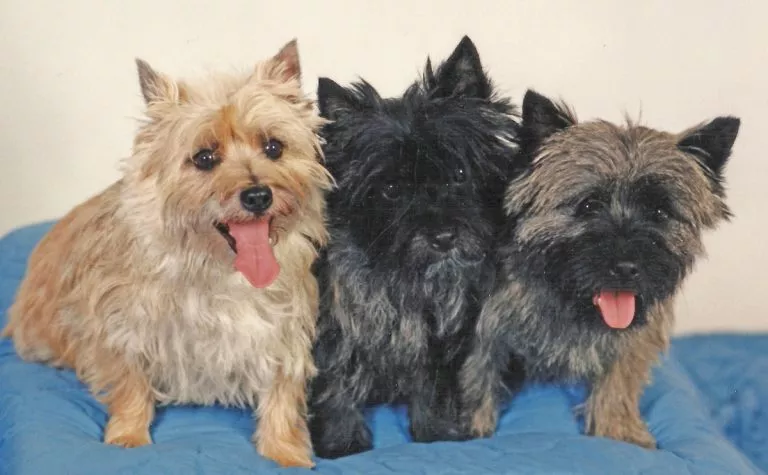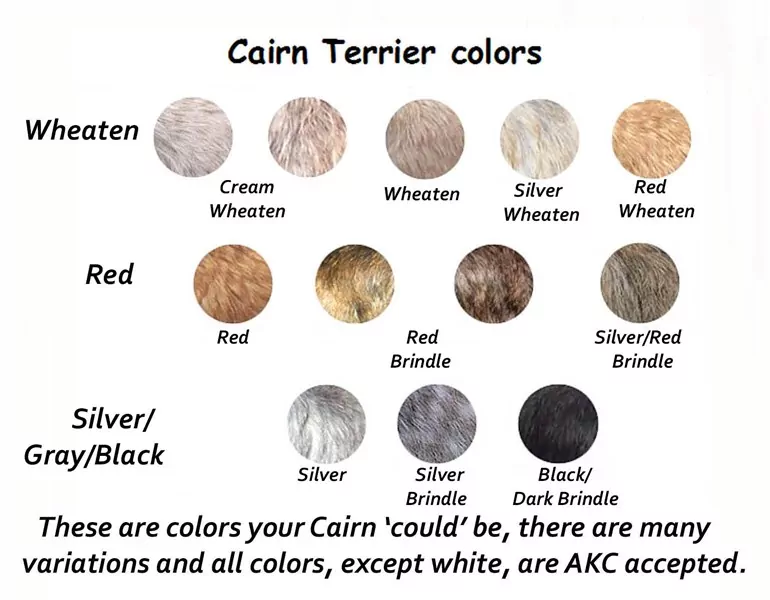Breed FAQ
Welcome to our Cairn Frequently Asked Questions (FAQ)! Here you’ll find answers to commonly asked questions about the Cairn breed.

Frequently Asked Questions
People give Cairns up for the same reasons people give up any dog. Some of the reasons we hear most often are: death, illness, divorce, moving, allergies and financial problems. It is not unusual to have even the most loving household experience health or personal problems that necessitate the placement of their pets. The most common reason is that the owner doesn’t have time for the dog. As a result, the Cairn could develop behavior problems from lack of attention and training. Some Cairns are abandoned on the streets, some are turned in to shelters that are only able to hold dogs a day or two, while others are obtained through auctions or kennel closures.
It is very important for people to do research before getting any breed as a family member, terriers of course, require extra effort because they are headstrong and usually really smart. People that don’t do research, don’t know what to expect from the breed and turn the dog over for its natural behavior.
Fortunately, Cairns are a very adaptable breed and rescue Cairns adapt well to new situations with the proper care and training.
Cairns can live well into their teens, and most are still very active and alert at 10 years of age and older.
Cairns come in a variety of colors, ranging from cream to wheaten (straw colored), red, gold, and shades of grey, to almost solid black. Their coat can be almost a single solid color, such as solid wheaten, or it can have a “brindle” coat (multiple colors in the coat, but not spotted). White is not a Cairn color. A “white Cairn” is most likely a West Highland White Terrier, commonly known as a Westie.
All Cairns are attractive, and no color holds special mention. You will love your Cairn whatever the color. A Cairn coat is typically a double coat, with a soft undercoat and a harsh outer coat. You should also be aware that Cairns MAY change color, often several times during their life.
Wheaten, Red Wheaten, Cream Wheaten, Red, Wheaten w/Black Points, Red w/Black Points, Silver Brindle, Red Brindle, Black Brindle, Silver w/Black Points – and on and on. There is a Black and Tan color known as Grease or Oil Rag, which is not a good color in the show ring for a Cairn…but most rescue dogs aren’t show dogs, but can be AKC registered to perform in agility, obedience, fly ball and earth dog.

Cairns typically weigh between 13 and 17 pounds. However, it is not unusual to see a Cairn weighing 20 pounds or slightly more and still be in good weight. Males tend to be larger in structure than the females.
Some Cairns would be wonderful with a senior depending on the individual energy levels of the dog and the people. As a rule, Cairns are an active breed; however, they do mellow some with age. Senior or more mature Cairns are recommended for those in their “golden years.”
Like humans, that depends on the individual situation. Your Placement Specialist will discuss this with you when you are approved to adopt.
Most of the Cairns we receive are older and already have an established history with or without a reaction to cats. Rescue Cairns who have not previously lived successfully with a cat generally do not get along with a cat, particularly because of their breeding as hunting dogs. Another thing to keep in mind is that just because a Cairn previously lived with a cat, it doesn’t necessarily mean it will get along with other cats, since the Cairn may react positively only with its previous cat companion.
In general, the Cairn is a healthy breed. For more information, see www.cairnterrier.org/reboot/health.html.
One advantage to adopting an older Cairn is that it is easier to determine if there will be any health issues than it is with a young puppy.
Over all, the Cairn requires less grooming than most other breeds. Routine grooming should include regular brushing, toenail clipping or filing, teeth brushing, and occasional baths. In addition, hand stripping should be done periodically to remove dead hair and permit new hair growth.
A rescue Cairn is not familiar usually, with a grooming process. Clipping the coat of a Cairn is truly acceptable and can be done professionally or by the dog owner. Using the Mars Coat King and Furminator in between clipping will keep your shedding to a sure minimum and keep the coat maintained so that clipping should only occur twice a year.
In general, Cairns are very loving dogs. Some do tend to be somewhat independent, especially when young, while others may love to sit in your lap for hours. Cairns are a very devoted breed, although most do not “hover” at your every move. Cairns are a mentally strong breed. They are smart, they will sense your needs as well, and you may not start out with a lap dog, but once that dog figures out your needs, you may eventually have one.
Some Cairns bark, while others hardly bark at all. In general, Cairns make good watchdogs and will often let you know when there are strangers (or squirrels) in the vicinity.
In general, Cairns will dig. However, some are not interested in digging at all. It depends on the individual dog. By keeping the nails short, and with training, many of those who do dig can learn not to. Never leaving a Cairn unattended in a fenced yard will insure your “digger” will not work those very strong front paws and get out under your fence!
Whether or not a Cairn likes riding in cars depends on the individual dog. Typically a Cairn is not prone to carsickness. A Cairn should either be secured in a seat belt harness or in a crate when traveling in a vehicle. This will protect you and your Cairn in the event of an accident.
Since all allergies in all people are different, it is hard to say that any dog is hypoallergenic, even those that do not shed. The dander coming off the skin of a dog is what causes most allergies. So we cannot say that Cairns are hypoallergenic, but if groomed regularly and properly, there is less chance of a human having an allergic reaction.
Yes, Toto was a Cairn Terrier. Read Toto: The Other Side of the Story.
If there is no fenced yard, Cairns must be exercised on a leash. Cairns were bred to hunt and it is impossible to train them to resist the urge to chase squirrels, cats, rabbits, other dogs, etc.
Cairns are NOT suited for invisible fencing because they will most likely take a “hit” in order to chase something through the fence. However, they won’t take the hit to get back home. In addition, invisible fencing does not prevent attacks from larger dogs. Likewise, a Cairn should not be left tied out in a yard for the same reason.
WE DO NOT require adoptive homes to have a fenced in yard, but the dog cannot be allowed off leash, EVER.
